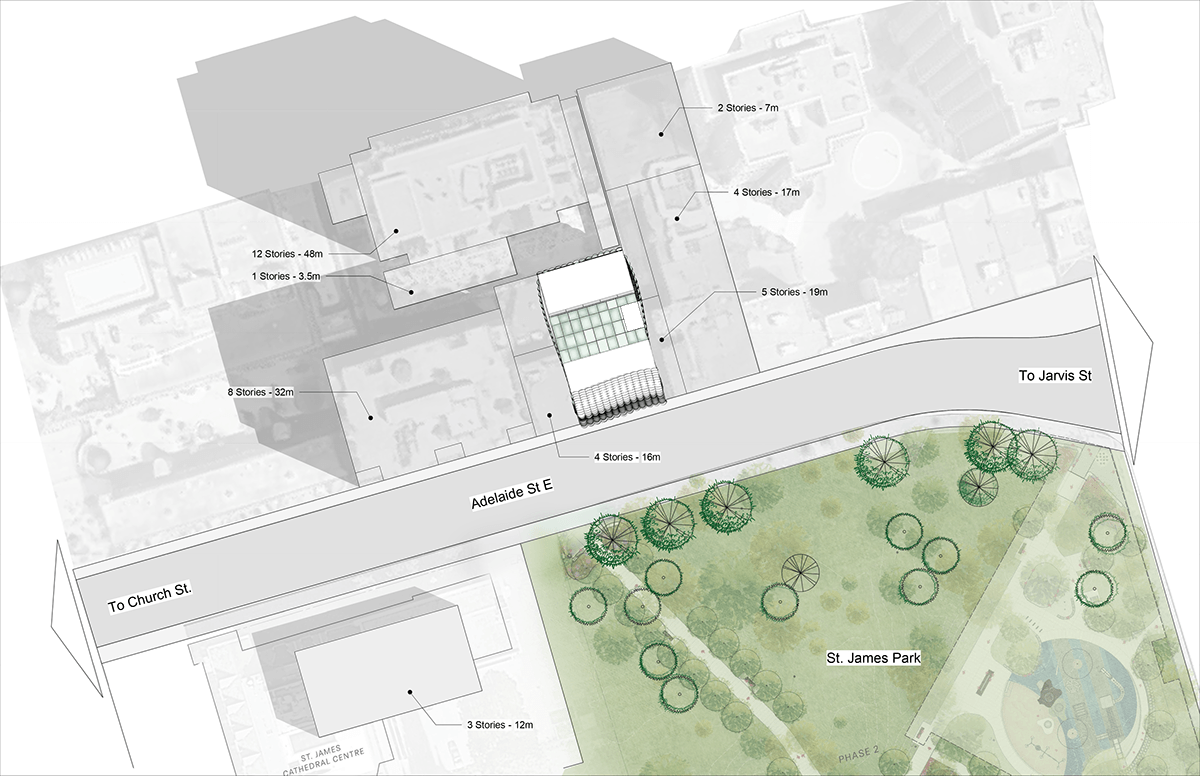- M.Arch Thesis Design Project - Toronto Metropolitan University (Ryerson University) - Oct 2019 to Aug 2020
- Parametric, biomimetic and daylighting design focus, physical prototyping with material experiments

Night View from St. James Park
The office building project serves as an ambitious experiment aimed at addressing two fundamental challenges related to daylight in urban environments: the scarcity of daylight in high-rise structures and the excessive daylight resulting from fully transparent facades.

Site Plan
110 Adelaide St. E , Toronto

Day View from St. James Park



The application of inflatable geometries on the building façade allows for the achievement of biomimetic flexibility and elasticity. By utilizing a synthetic material with properties that resemble those found in the natural world, such as flora and fauna, the façade embodies organic characteristics.
Leaves optimize their boundary layers by developing and arranging trichomes, commonly known as "hairs." These spherical and translucent structures form tiny bubbles, creating a hydraulic inflation. Varying in size, these inflated trichomes maximize the air buffer zone while allowing an optimal amount of sunlight to penetrate the chlorophyll-rich areas beneath them.



Nature Inspires - Foam bubbles bundled together to create stronger shelters for spittlebug during the vulnerable stage of life.
Embracing the realm of soft material technology, contemporary designers embark on a captivating journey towards biomimetic design. Unlike their rigid counterparts, soft materials exhibit greater compliance with the human body, offering new possibilities for ergonomic and user-centric solutions.
Morphogenetic forms cannot be studied in isolation but must be examined collectively, as forces propagate sequentially from one configuration to another. The interplay of relational patterns and material properties gives rise to the emergent characteristics of the overall form they inhabit.





The daylight calculation process utilizing DIVA-Grasshopper involves setting a threshold of 300 Lux to determine the inflation intensity of the units. Cells that receive lower illuminance values will have a higher amount of air pumped into them, ensuring optimal distribution of daylight throughout the space.
The utilization of larger pneumatic cells allows for increased transparency, enabling a greater amount of daylight to pass through the material layer. Through the process of materialization, the translucent variations of silicone rubber effectively diffuse direct sunlight, transforming the envelope system into a responsive light source.





Emergent Translucency: Tailoring Interior Functions with Versatility
During working hours, occupants often encounter discomfort caused by excessive heat and glare. In colder weather, a higher glazing fraction can lead to increased heat loss, resulting in higher insulation costs. To address these challenges, the transition from multilayer shading systems to pneumatic-translucent systems has proven effective. This innovative hybrid envelope combines translucency and pneumatic features to create a multifunctional and cohesive surface. By integrating these disparate functions, the envelope not only mitigates glare and heat gain but also defines the overall form of the building, offering occupants a rich and immersive experience.

Cable connections and steel bracing systems allow a flexible movement for the pneumatic units
